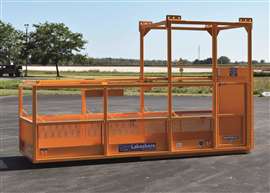Reaching new heights: the role of man baskets in specialized crane operations
21 October 2024
In the realm of lifting, there are times when the crew needs to get up close to the elements that are being hoisted. While there are a variety of personnel lifting solutions, a man basket is often the answer.
 Providing access via a crane and man basket requires specialized equipment and know-how, but it is a tried and true practice. PHOTO: Lifting Technologies
Providing access via a crane and man basket requires specialized equipment and know-how, but it is a tried and true practice. PHOTO: Lifting Technologies
Providing access via a crane and a man basket requires specialized equipment and know-how, but it is a tried and true practice that is safe and practical.
“This often requires unique and specific solutions,” said Kyle Haskell, president, Lakeshore Industrial, based in Two Rivers, Wisconsin. “That’s where products such as our cantilever man basket come into play.
Cantilever baskets are most often used to work under overhangs and other hard-to-reach areas.
“Our cantilever man baskets have been used to work under the Gordie Howe International Bridge, at the highest point of a Salt Lake City Airport Tower, on the shores of Kaunakakai Harbor and many more jobsites,” Haskell said. “Each of these jobs is unique and requires a high level of attention to detail to ensure the safety of everyone involved.”
Lakeshore Industrial’s line of cantilever baskets range in size from a 3-foot walk-out deck, all the way to a 17-foot deck. Haskell said the design of its cantilever baskets exceed OSHA and ASME guidelines and regulations.
 Lakeshore Industrial’s cantilever man baskets were designed to work under overhangs and other hard-to-reach areas, such as under bridges. PHOTO: Lakeshore Industrial
Lakeshore Industrial’s cantilever man baskets were designed to work under overhangs and other hard-to-reach areas, such as under bridges. PHOTO: Lakeshore Industrial
“With many spots to hook up your safety harnesses, you can have safe access all through the basket,” he said. “Our specialized rigging, along with a heavy counterweight, keeps the work platform within 10 degrees when lifted no matter where you stand in the basket. All of our man baskets include test weights that are at 125 percent of the weight capacity. We also test load them in shop at 200 percent to ensure compliance with ASME requirements.”
Safe and efficient
Lifting Technologies produces OSHA-compliant crane-suspended personnel hoisting platforms.
“A significant number of our platforms are still in service after decades of rigorous use,” said Steve Jacobs, regional business development manager, Lifting Technologies, based in Missoula, Montana. “Our designs incorporate fully welded round or square tube steel frames, sag-proof grating floors, and incorporate I-beam frames for larger capacities providing the ultimate in support foundations.”
LT’s sling assemblies incorporate swage sockets and large diameter pins for connection to lifting eyes, eliminating the unstable misalignment often caused by shackles.
“These specifications ensure the most reliably safe and strong design available,” said Jacobs. “Our craftsmanship, rapid on/off test weight system and warranty provide quality and safety.”
The REC4-1200SO man basket was designed for a ship building facility to transport fabrication personnel alongside vessels. It utilizes telescoping roller systems and heavy-duty bumpers to mitigate steel-to-steel contact,” he said. “Supported by I-beam frame and fork tubes this platform is so successful we’ve been asked to build a revised version for a national roofing company.



